SITXGLC001 - Induction Manual for Regulatory Compliance in Hospitality
VerifiedAdded on 2023/06/16
|9
|1357
|235
Report
AI Summary
This report details the development of an induction manual for a hospitality business, focusing on regulatory compliance as per SITXGLC001 requirements. It nominates personnel for induction, policy distribution, and information updates, emphasizing continuous improvement for legal and licensing adherence. The report outlines essential elements of an employee handbook, including anti-discrimination policies, Australian Consumer Law, contract management, superannuation contributions, environmental protection, Fair Work Act compliance, local community protection, taxation, workplace relations, public liability, work health and safety, and workers' compensation. The document provides a comprehensive guide for hospitality businesses to ensure effective employee onboarding and adherence to legal and ethical standards.
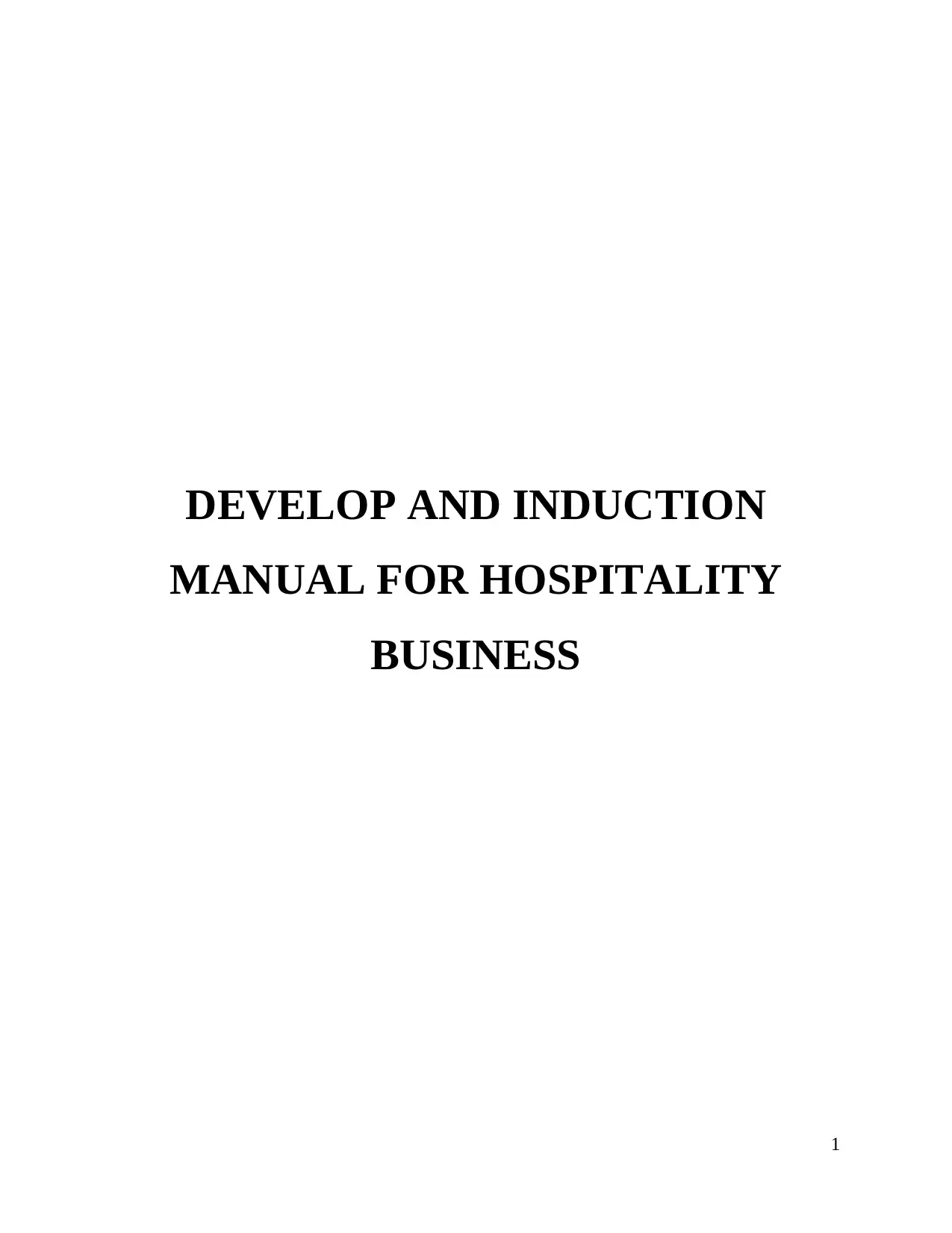
DEVELOP AND INDUCTION
MANUAL FOR HOSPITALITY
BUSINESS
1
MANUAL FOR HOSPITALITY
BUSINESS
1
Paraphrase This Document
Need a fresh take? Get an instant paraphrase of this document with our AI Paraphraser
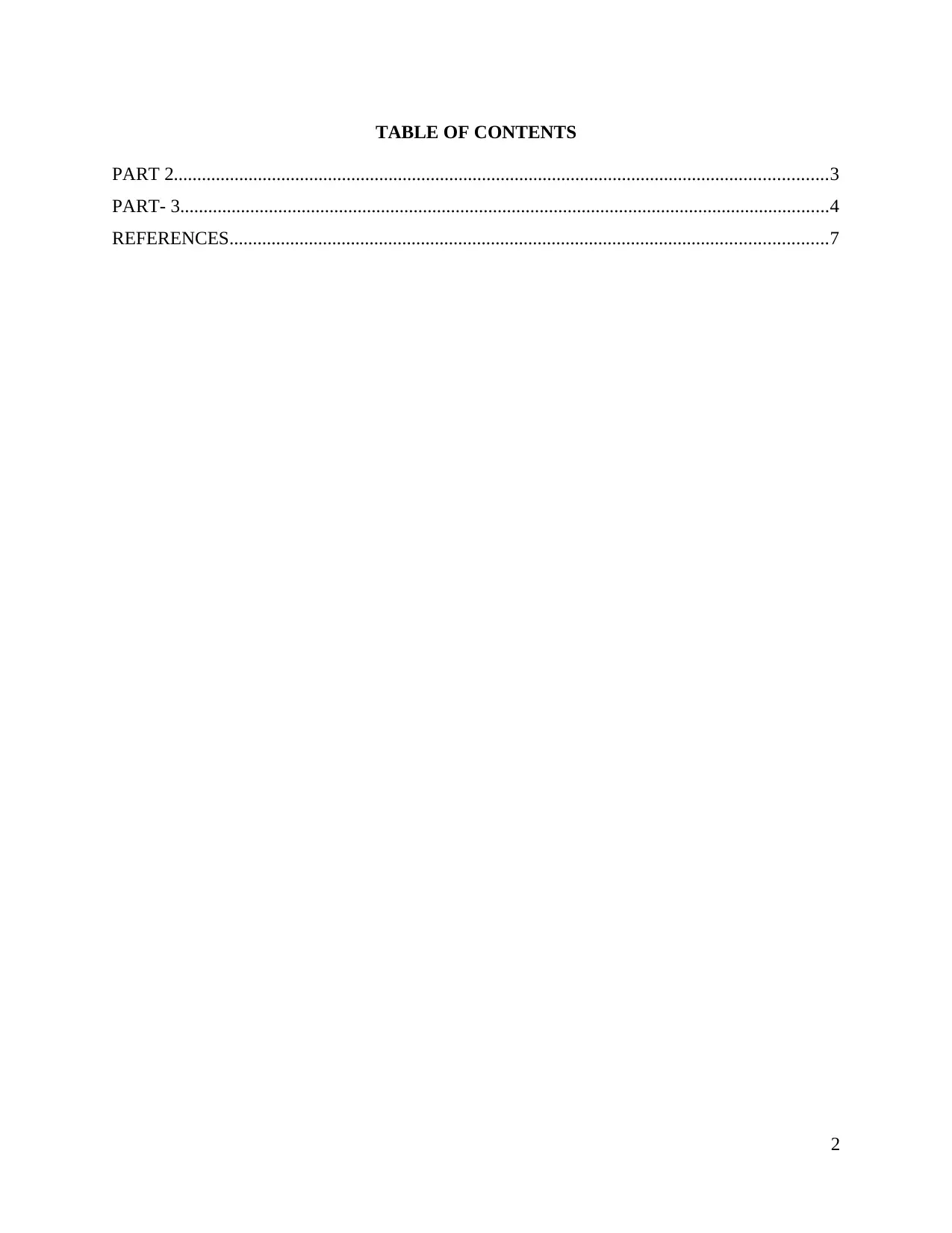
TABLE OF CONTENTS
PART 2............................................................................................................................................3
PART- 3...........................................................................................................................................4
REFERENCES................................................................................................................................7
2
PART 2............................................................................................................................................3
PART- 3...........................................................................................................................................4
REFERENCES................................................................................................................................7
2
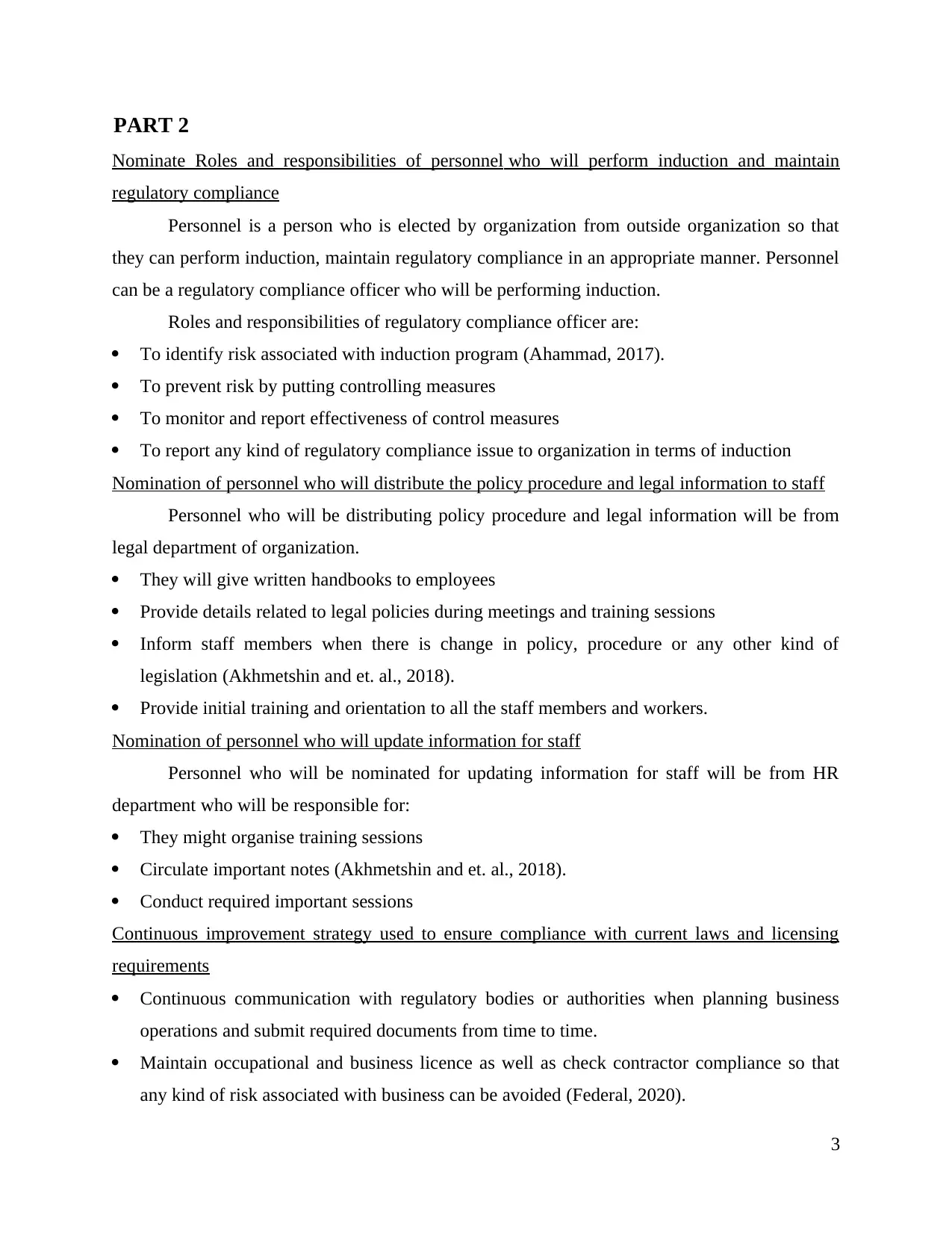
PART 2
Nominate Roles and responsibilities of personnel who will perform induction and maintain
regulatory compliance
Personnel is a person who is elected by organization from outside organization so that
they can perform induction, maintain regulatory compliance in an appropriate manner. Personnel
can be a regulatory compliance officer who will be performing induction.
Roles and responsibilities of regulatory compliance officer are:
To identify risk associated with induction program (Ahammad, 2017).
To prevent risk by putting controlling measures
To monitor and report effectiveness of control measures
To report any kind of regulatory compliance issue to organization in terms of induction
Nomination of personnel who will distribute the policy procedure and legal information to staff
Personnel who will be distributing policy procedure and legal information will be from
legal department of organization.
They will give written handbooks to employees
Provide details related to legal policies during meetings and training sessions
Inform staff members when there is change in policy, procedure or any other kind of
legislation (Akhmetshin and et. al., 2018).
Provide initial training and orientation to all the staff members and workers.
Nomination of personnel who will update information for staff
Personnel who will be nominated for updating information for staff will be from HR
department who will be responsible for:
They might organise training sessions
Circulate important notes (Akhmetshin and et. al., 2018).
Conduct required important sessions
Continuous improvement strategy used to ensure compliance with current laws and licensing
requirements
Continuous communication with regulatory bodies or authorities when planning business
operations and submit required documents from time to time.
Maintain occupational and business licence as well as check contractor compliance so that
any kind of risk associated with business can be avoided (Federal, 2020).
3
Nominate Roles and responsibilities of personnel who will perform induction and maintain
regulatory compliance
Personnel is a person who is elected by organization from outside organization so that
they can perform induction, maintain regulatory compliance in an appropriate manner. Personnel
can be a regulatory compliance officer who will be performing induction.
Roles and responsibilities of regulatory compliance officer are:
To identify risk associated with induction program (Ahammad, 2017).
To prevent risk by putting controlling measures
To monitor and report effectiveness of control measures
To report any kind of regulatory compliance issue to organization in terms of induction
Nomination of personnel who will distribute the policy procedure and legal information to staff
Personnel who will be distributing policy procedure and legal information will be from
legal department of organization.
They will give written handbooks to employees
Provide details related to legal policies during meetings and training sessions
Inform staff members when there is change in policy, procedure or any other kind of
legislation (Akhmetshin and et. al., 2018).
Provide initial training and orientation to all the staff members and workers.
Nomination of personnel who will update information for staff
Personnel who will be nominated for updating information for staff will be from HR
department who will be responsible for:
They might organise training sessions
Circulate important notes (Akhmetshin and et. al., 2018).
Conduct required important sessions
Continuous improvement strategy used to ensure compliance with current laws and licensing
requirements
Continuous communication with regulatory bodies or authorities when planning business
operations and submit required documents from time to time.
Maintain occupational and business licence as well as check contractor compliance so that
any kind of risk associated with business can be avoided (Federal, 2020).
3
⊘ This is a preview!⊘
Do you want full access?
Subscribe today to unlock all pages.

Trusted by 1+ million students worldwide
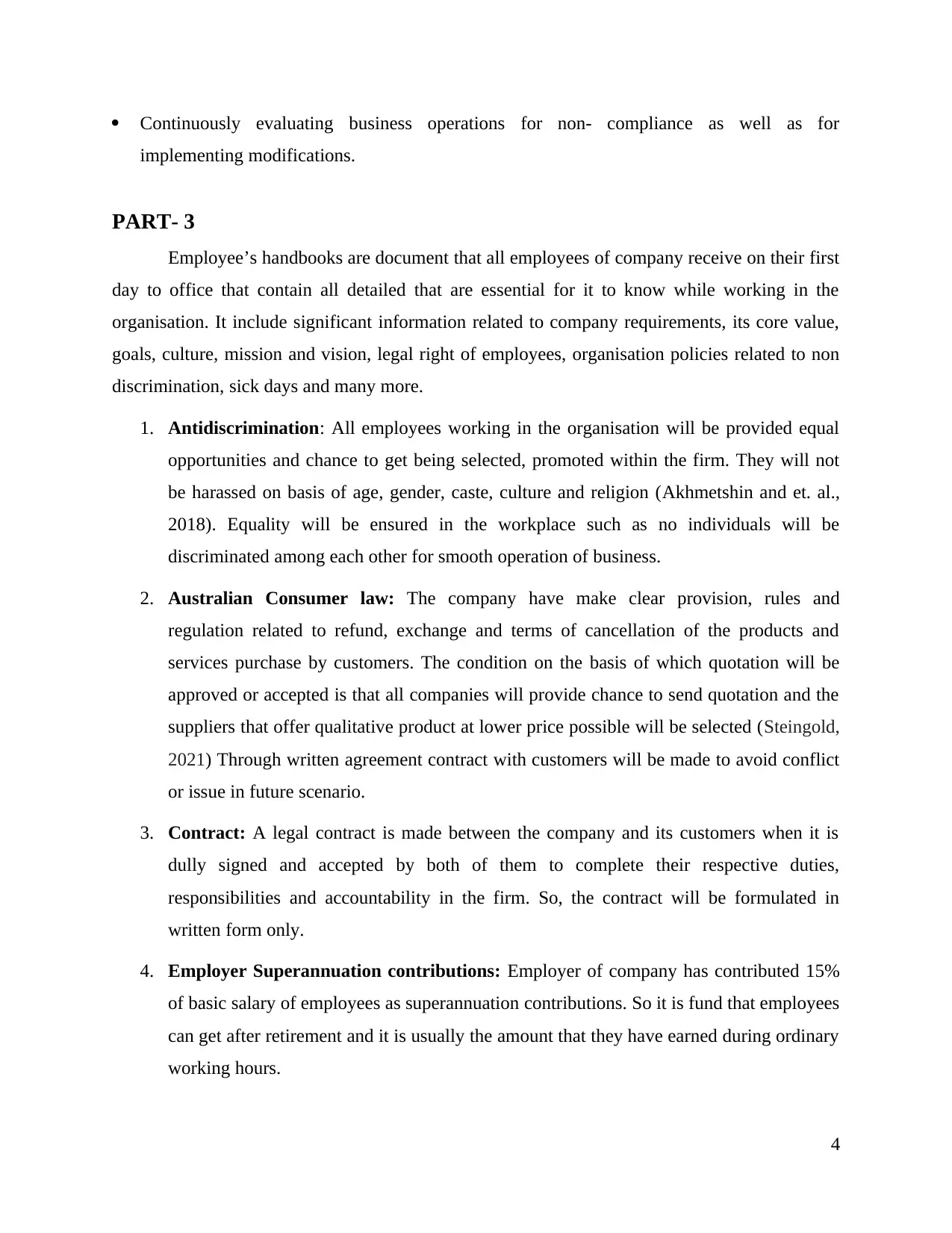
Continuously evaluating business operations for non- compliance as well as for
implementing modifications.
PART- 3
Employee’s handbooks are document that all employees of company receive on their first
day to office that contain all detailed that are essential for it to know while working in the
organisation. It include significant information related to company requirements, its core value,
goals, culture, mission and vision, legal right of employees, organisation policies related to non
discrimination, sick days and many more.
1. Antidiscrimination: All employees working in the organisation will be provided equal
opportunities and chance to get being selected, promoted within the firm. They will not
be harassed on basis of age, gender, caste, culture and religion (Akhmetshin and et. al.,
2018). Equality will be ensured in the workplace such as no individuals will be
discriminated among each other for smooth operation of business.
2. Australian Consumer law: The company have make clear provision, rules and
regulation related to refund, exchange and terms of cancellation of the products and
services purchase by customers. The condition on the basis of which quotation will be
approved or accepted is that all companies will provide chance to send quotation and the
suppliers that offer qualitative product at lower price possible will be selected (Steingold,
2021) Through written agreement contract with customers will be made to avoid conflict
or issue in future scenario.
3. Contract: A legal contract is made between the company and its customers when it is
dully signed and accepted by both of them to complete their respective duties,
responsibilities and accountability in the firm. So, the contract will be formulated in
written form only.
4. Employer Superannuation contributions: Employer of company has contributed 15%
of basic salary of employees as superannuation contributions. So it is fund that employees
can get after retirement and it is usually the amount that they have earned during ordinary
working hours.
4
implementing modifications.
PART- 3
Employee’s handbooks are document that all employees of company receive on their first
day to office that contain all detailed that are essential for it to know while working in the
organisation. It include significant information related to company requirements, its core value,
goals, culture, mission and vision, legal right of employees, organisation policies related to non
discrimination, sick days and many more.
1. Antidiscrimination: All employees working in the organisation will be provided equal
opportunities and chance to get being selected, promoted within the firm. They will not
be harassed on basis of age, gender, caste, culture and religion (Akhmetshin and et. al.,
2018). Equality will be ensured in the workplace such as no individuals will be
discriminated among each other for smooth operation of business.
2. Australian Consumer law: The company have make clear provision, rules and
regulation related to refund, exchange and terms of cancellation of the products and
services purchase by customers. The condition on the basis of which quotation will be
approved or accepted is that all companies will provide chance to send quotation and the
suppliers that offer qualitative product at lower price possible will be selected (Steingold,
2021) Through written agreement contract with customers will be made to avoid conflict
or issue in future scenario.
3. Contract: A legal contract is made between the company and its customers when it is
dully signed and accepted by both of them to complete their respective duties,
responsibilities and accountability in the firm. So, the contract will be formulated in
written form only.
4. Employer Superannuation contributions: Employer of company has contributed 15%
of basic salary of employees as superannuation contributions. So it is fund that employees
can get after retirement and it is usually the amount that they have earned during ordinary
working hours.
4
Paraphrase This Document
Need a fresh take? Get an instant paraphrase of this document with our AI Paraphraser
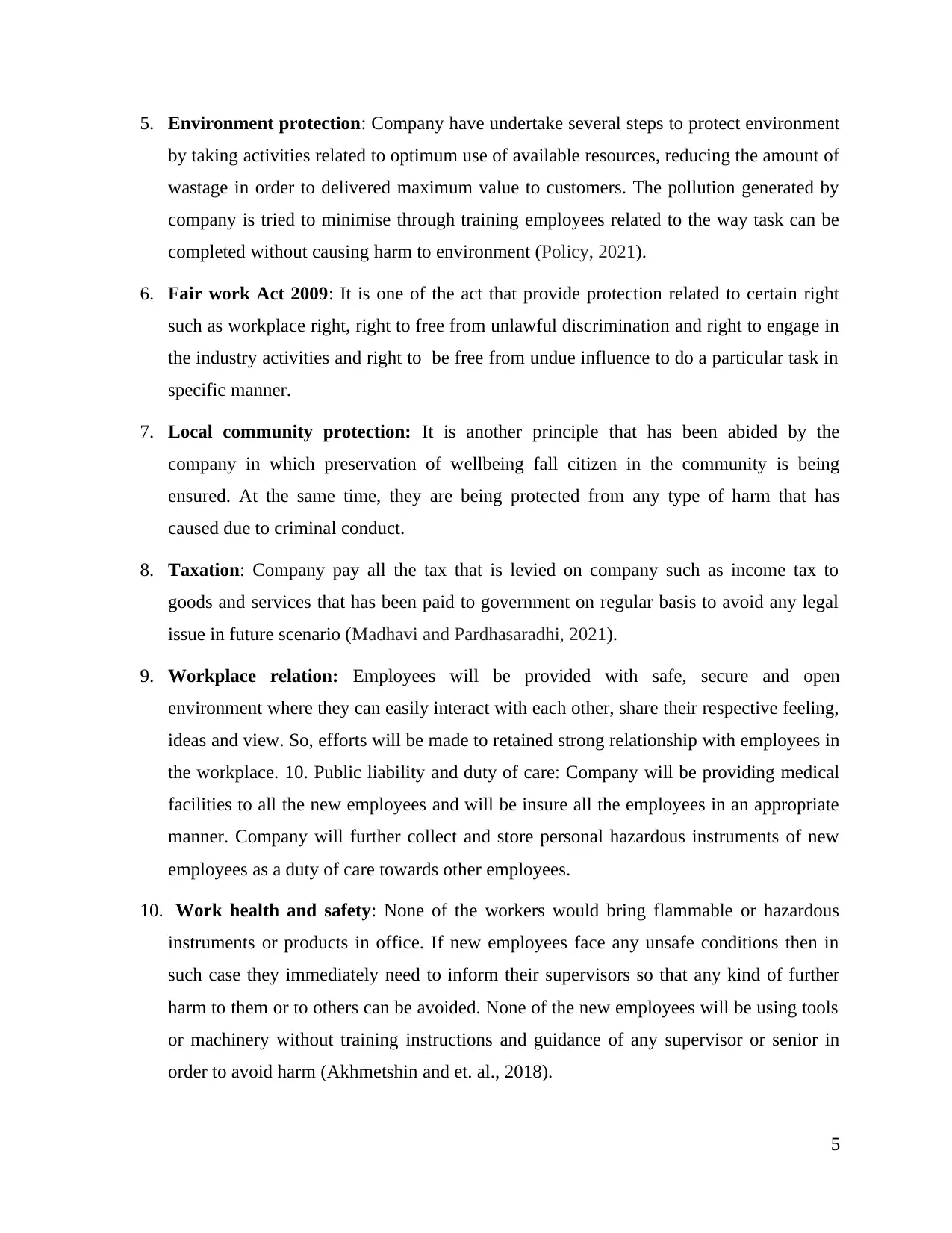
5. Environment protection: Company have undertake several steps to protect environment
by taking activities related to optimum use of available resources, reducing the amount of
wastage in order to delivered maximum value to customers. The pollution generated by
company is tried to minimise through training employees related to the way task can be
completed without causing harm to environment (Policy, 2021).
6. Fair work Act 2009: It is one of the act that provide protection related to certain right
such as workplace right, right to free from unlawful discrimination and right to engage in
the industry activities and right to be free from undue influence to do a particular task in
specific manner.
7. Local community protection: It is another principle that has been abided by the
company in which preservation of wellbeing fall citizen in the community is being
ensured. At the same time, they are being protected from any type of harm that has
caused due to criminal conduct.
8. Taxation: Company pay all the tax that is levied on company such as income tax to
goods and services that has been paid to government on regular basis to avoid any legal
issue in future scenario (Madhavi and Pardhasaradhi, 2021).
9. Workplace relation: Employees will be provided with safe, secure and open
environment where they can easily interact with each other, share their respective feeling,
ideas and view. So, efforts will be made to retained strong relationship with employees in
the workplace. 10. Public liability and duty of care: Company will be providing medical
facilities to all the new employees and will be insure all the employees in an appropriate
manner. Company will further collect and store personal hazardous instruments of new
employees as a duty of care towards other employees.
10. Work health and safety: None of the workers would bring flammable or hazardous
instruments or products in office. If new employees face any unsafe conditions then in
such case they immediately need to inform their supervisors so that any kind of further
harm to them or to others can be avoided. None of the new employees will be using tools
or machinery without training instructions and guidance of any supervisor or senior in
order to avoid harm (Akhmetshin and et. al., 2018).
5
by taking activities related to optimum use of available resources, reducing the amount of
wastage in order to delivered maximum value to customers. The pollution generated by
company is tried to minimise through training employees related to the way task can be
completed without causing harm to environment (Policy, 2021).
6. Fair work Act 2009: It is one of the act that provide protection related to certain right
such as workplace right, right to free from unlawful discrimination and right to engage in
the industry activities and right to be free from undue influence to do a particular task in
specific manner.
7. Local community protection: It is another principle that has been abided by the
company in which preservation of wellbeing fall citizen in the community is being
ensured. At the same time, they are being protected from any type of harm that has
caused due to criminal conduct.
8. Taxation: Company pay all the tax that is levied on company such as income tax to
goods and services that has been paid to government on regular basis to avoid any legal
issue in future scenario (Madhavi and Pardhasaradhi, 2021).
9. Workplace relation: Employees will be provided with safe, secure and open
environment where they can easily interact with each other, share their respective feeling,
ideas and view. So, efforts will be made to retained strong relationship with employees in
the workplace. 10. Public liability and duty of care: Company will be providing medical
facilities to all the new employees and will be insure all the employees in an appropriate
manner. Company will further collect and store personal hazardous instruments of new
employees as a duty of care towards other employees.
10. Work health and safety: None of the workers would bring flammable or hazardous
instruments or products in office. If new employees face any unsafe conditions then in
such case they immediately need to inform their supervisors so that any kind of further
harm to them or to others can be avoided. None of the new employees will be using tools
or machinery without training instructions and guidance of any supervisor or senior in
order to avoid harm (Akhmetshin and et. al., 2018).
5
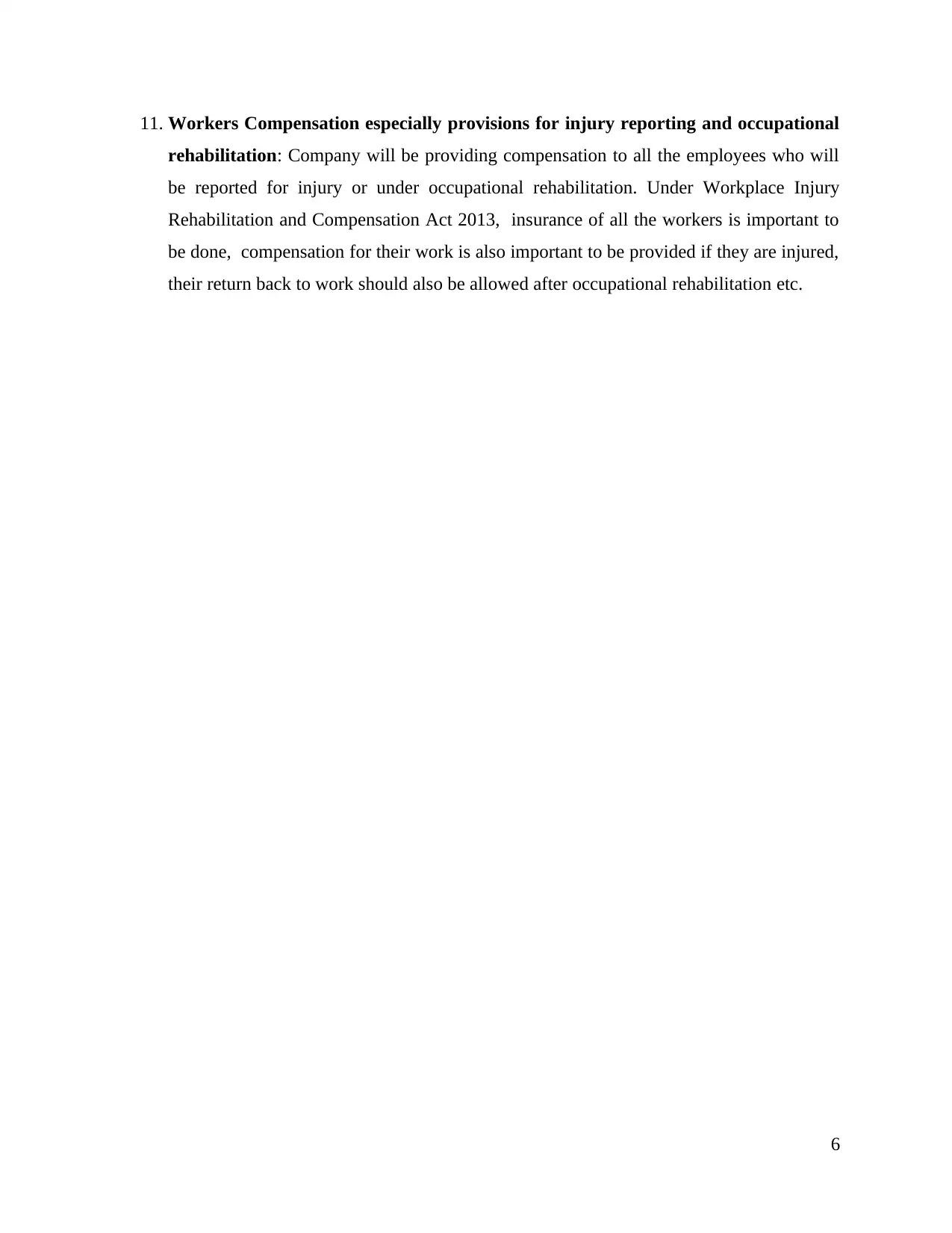
11. Workers Compensation especially provisions for injury reporting and occupational
rehabilitation: Company will be providing compensation to all the employees who will
be reported for injury or under occupational rehabilitation. Under Workplace Injury
Rehabilitation and Compensation Act 2013, insurance of all the workers is important to
be done, compensation for their work is also important to be provided if they are injured,
their return back to work should also be allowed after occupational rehabilitation etc.
6
rehabilitation: Company will be providing compensation to all the employees who will
be reported for injury or under occupational rehabilitation. Under Workplace Injury
Rehabilitation and Compensation Act 2013, insurance of all the workers is important to
be done, compensation for their work is also important to be provided if they are injured,
their return back to work should also be allowed after occupational rehabilitation etc.
6
⊘ This is a preview!⊘
Do you want full access?
Subscribe today to unlock all pages.

Trusted by 1+ million students worldwide
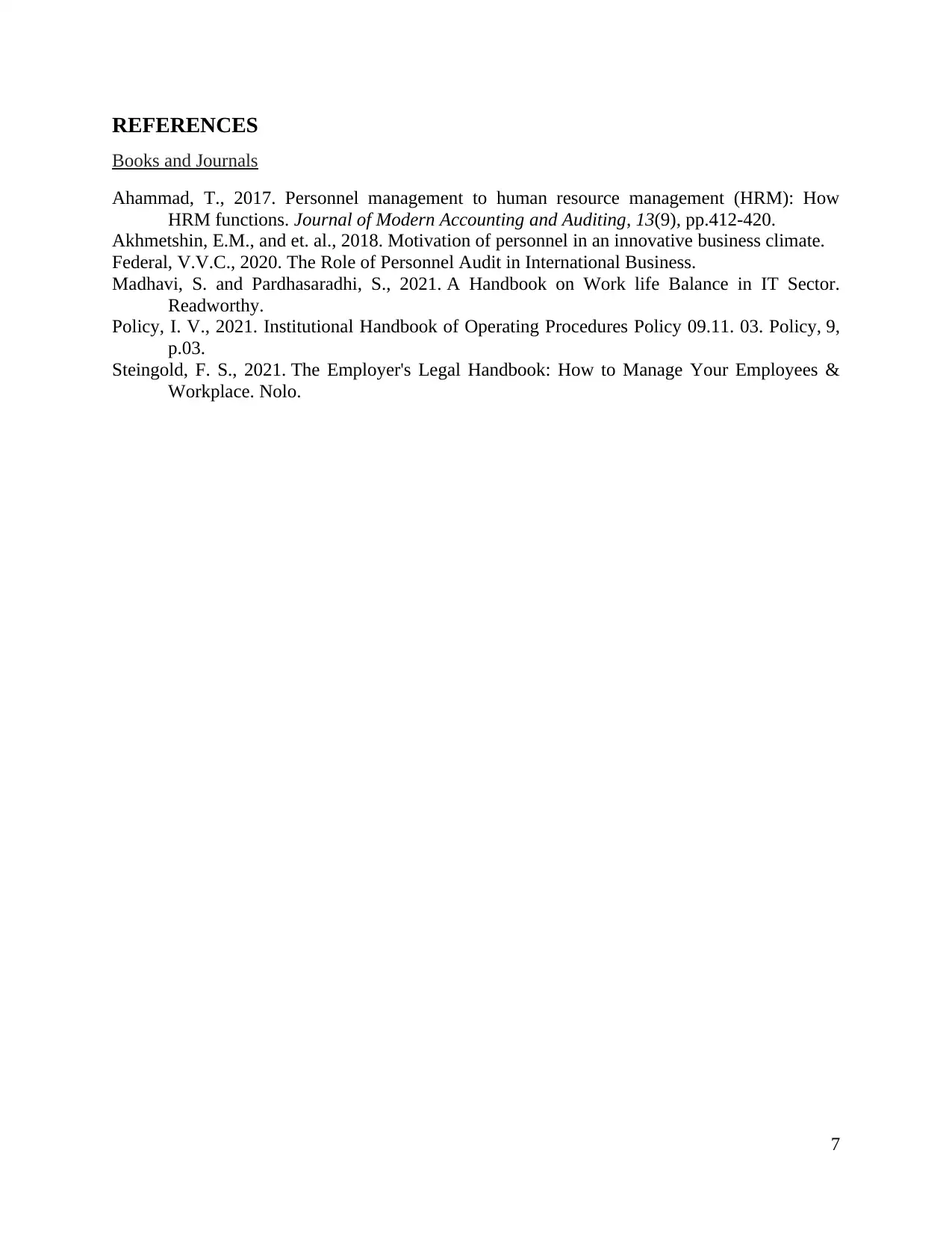
REFERENCES
Books and Journals
Ahammad, T., 2017. Personnel management to human resource management (HRM): How
HRM functions. Journal of Modern Accounting and Auditing, 13(9), pp.412-420.
Akhmetshin, E.M., and et. al., 2018. Motivation of personnel in an innovative business climate.
Federal, V.V.C., 2020. The Role of Personnel Audit in International Business.
Madhavi, S. and Pardhasaradhi, S., 2021. A Handbook on Work life Balance in IT Sector.
Readworthy.
Policy, I. V., 2021. Institutional Handbook of Operating Procedures Policy 09.11. 03. Policy, 9,
p.03.
Steingold, F. S., 2021. The Employer's Legal Handbook: How to Manage Your Employees &
Workplace. Nolo.
7
Books and Journals
Ahammad, T., 2017. Personnel management to human resource management (HRM): How
HRM functions. Journal of Modern Accounting and Auditing, 13(9), pp.412-420.
Akhmetshin, E.M., and et. al., 2018. Motivation of personnel in an innovative business climate.
Federal, V.V.C., 2020. The Role of Personnel Audit in International Business.
Madhavi, S. and Pardhasaradhi, S., 2021. A Handbook on Work life Balance in IT Sector.
Readworthy.
Policy, I. V., 2021. Institutional Handbook of Operating Procedures Policy 09.11. 03. Policy, 9,
p.03.
Steingold, F. S., 2021. The Employer's Legal Handbook: How to Manage Your Employees &
Workplace. Nolo.
7
Paraphrase This Document
Need a fresh take? Get an instant paraphrase of this document with our AI Paraphraser

8

9
⊘ This is a preview!⊘
Do you want full access?
Subscribe today to unlock all pages.

Trusted by 1+ million students worldwide
1 out of 9
Related Documents
Your All-in-One AI-Powered Toolkit for Academic Success.
+13062052269
info@desklib.com
Available 24*7 on WhatsApp / Email
![[object Object]](/_next/static/media/star-bottom.7253800d.svg)
Unlock your academic potential
Copyright © 2020–2025 A2Z Services. All Rights Reserved. Developed and managed by ZUCOL.





